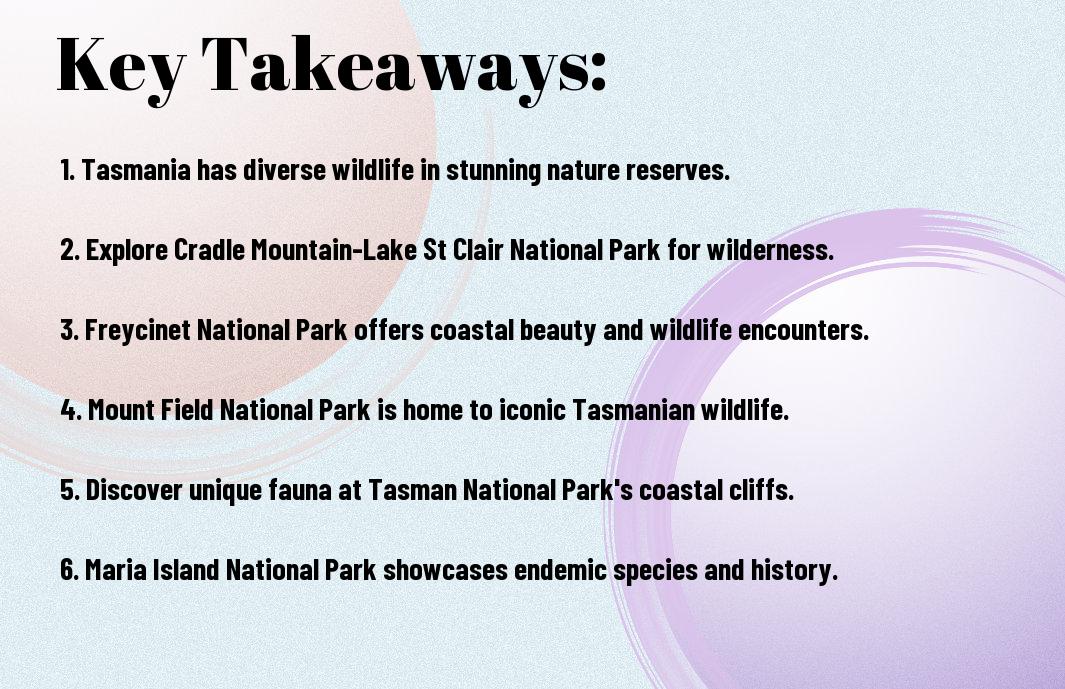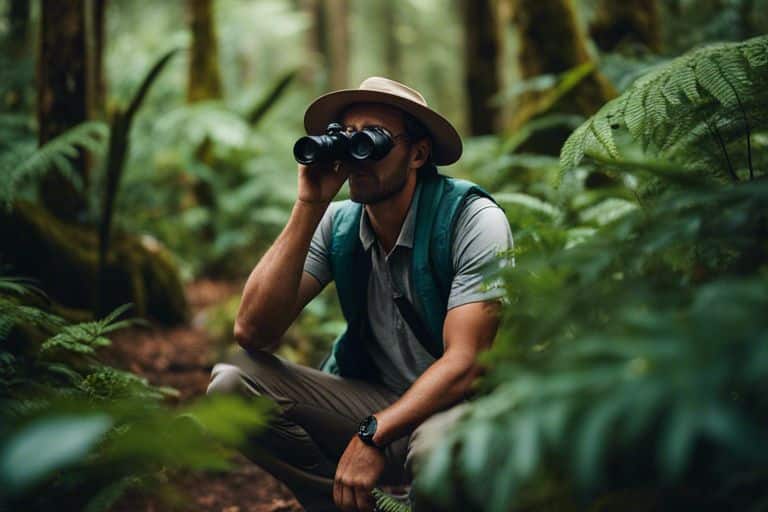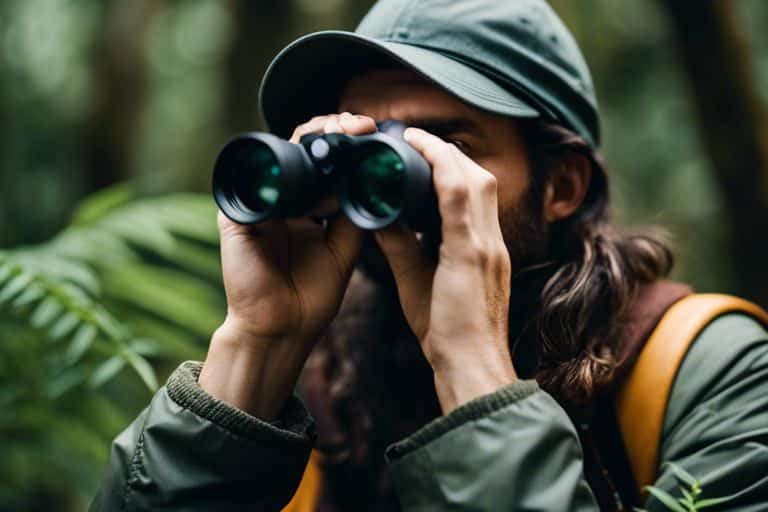Are you a nature enthusiast looking to explore Tasmania‘s diverse wildlife? Look no further than the island’s best nature reserves, where you can immerse yourself in some of the most breathtaking and unique landscapes on Earth. Tasmania is home to a wide variety of flora and fauna, including many species that are found nowhere else in the world.
From the rugged mountains of Cradle Mountain-Lake St Clair National Park to the pristine beaches of Freycinet National Park, Tasmania offers something for every nature lover. Explore the lush rainforests of Hartz Mountains National Park or marvel at the stunning coastal cliffs of the Tasman National Park. Whether you’re interested in birdwatching, hiking, or simply soaking in the serene beauty of nature, Tasmania has it all.
But remember, while Tasmania’s nature reserves are truly remarkable, they can also be unforgiving if you’re not prepared. Make sure to follow all safety guidelines and respect the fragile ecosystem during your visit. So pack your bags, grab your camera, and get ready for the wildlife adventure of a lifetime in Tasmania’s best nature reserves.
Key Takeaways:
- Tasmania is home to diverse wildlife: Tasmania boasts a wide variety of unique animals, from Tasmanian devils to pademelons and quolls.
- Explore iconic nature reserves: Discover famous nature reserves like Freycinet National Park, Mount Field National Park, and Tasman National Park.
- See endemic species: Tasmania is a haven for endemic species, including the Tasmanian devil and the Tasmanian pademelon.
- Enjoy outdoor activities: Nature reserves in Tasmania offer a range of outdoor activities, such as hiking, bird watching, and wildlife spotting.
- Experience breathtaking landscapes: Tasmania’s nature reserves are known for their stunning landscapes, including rugged coastlines, ancient forests, and picturesque waterfalls.
- Learn about conservation efforts: Many nature reserves in Tasmania are involved in conservation initiatives to protect endangered species and habitats.
- Plan your visit carefully: Before visiting nature reserves in Tasmania, make sure to check for any seasonal closures, weather conditions, and entry requirements.
What Makes Tasmania Special?
It is no secret that Tasmania is a wildlife enthusiast’s paradise. From its rugged mountains to pristine coastlines, the island offers a diverse range of habitats that support a myriad of unique species. If you’re looking to experience the best of Tasmania’s natural wonders, look no further than Tasmanian Wildlife Tours | Wilderness Tours, Nature &…
Geographic Isolation and Its Impact
What sets Tasmania apart is its geographic isolation. Separated from mainland Australia by the Bass Strait, the island has evolved in isolation for millions of years. This isolation has led to the development of a distinct ecosystem with a high level of endemism. Many species found in Tasmania are unique to the island and cannot be found anywhere else in the world.
For those interested in wildlife, this means the opportunity to encounter species that are not only rare but also incredibly special. The endemic species found in Tasmania include the Tasmanian devil, the eastern quoll, and the Tasmanian pademelon. Exploring Tasmania’s nature reserves allows visitors to witness these remarkable creatures in their natural habitats, offering a truly unforgettable experience.
The Climate and Ecosystem Diversity
For a relatively small island, Tasmania boasts an impressive range of climates and ecosystems. From the cool temperate rainforests of the Southwest National Park to the alpine heathlands of Cradle Mountain, the island’s diverse landscapes support a wide variety of flora and fauna. This ecosystem diversity is a result of Tasmania’s unique geography and climate, making it a hotspot for biodiversity.
Understanding the intricacies of Tasmania’s climate and ecosystems is crucial for appreciating the island’s natural beauty. The cool, temperate climate of Tasmania supports a mix of species from both temperate and sub-Antarctic regions. This creates a rich tapestry of habitats that are home to a plethora of unique plants and animals. Whether you’re a seasoned wildlife enthusiast or a casual nature lover, exploring Tasmania’s nature reserves will leave you in awe of the island’s remarkable biodiversity.
Planning Your Wildlife Adventure
Despite the abundance of wildlife in Tasmania, planning ahead for your wildlife adventure is crucial to ensure a memorable and safe experience. To make the most of your journey, consider taking a Wildlife in Tasmania | Wildlife Tours that can provide expert guidance and insight into the region’s diverse flora and fauna.
Best Times to Visit Tasmanian Nature Reserves
On your quest to discover Tasmania’s wildlife, timing is key. The best times to visit Tasmanian nature reserves are during the spring months from September to November and in the autumn months from March to May. During these seasons, you will have the opportunity to witness an array of wildlife species, including echidnas, wallabies, and Tasmanian devils, in their natural habitats.
Visiting during these periods also offers milder weather conditions, making outdoor activities more enjoyable. Keep in mind that certain wildlife species may be more active during specific times of the day, such as early morning or dusk, so plan your visits accordingly to maximize your chances of spotting these incredible creatures.
For bird enthusiasts, the summer months from December to February are ideal for birdwatching as many migratory species can be observed during this time. Winter, from June to August, may offer fewer wildlife sightings due to hibernation or migration patterns.
Essential Gear and Preparations
When venturing into Tasmanian nature reserves to search for wildlife, it is crucial to be prepared with the right gear and provisions. Pack appropriate clothing for varying weather conditions, including sturdy hiking boots, warm layers, and rain gear to stay comfortable and dry throughout your excursion.
Carrying a pair of binoculars and a camera with a telephoto lens is advisable to get a closer look and capture stunning photos of the wildlife from a safe distance. Additionally, bring along a field guide to identify different species you may encounter during your visit.
Before setting out, familiarize yourself with the rules and regulations of the nature reserves, including any permits or entry fees required. Respect wildlife habitats by refraining from littering, feeding the animals, or approaching them too closely. By practicing responsible eco-tourism, you contribute to the preservation of Tasmania’s precious ecosystems for future generations to enjoy.
Visiting Tasmania’s nature reserves for a wildlife adventure is a thrilling experience that requires proper planning and consideration. By choosing the best times to visit, packing crucial gear, and respecting the environment, you can begin on a journey filled with memorable encounters and breathtaking sights of the island’s unique fauna. Immerse yourself in the wonders of Tasmania’s vast wilderness and create unforgettable moments in the heart of nature.
Spotlight on Key Tasmanian Reserves
Freycinet National Park
For nature enthusiasts seeking a pristine Tasmanian wilderness experience, Freycinet National Park is a must-visit destination. Located on the stunning east coast of Tasmania, this park is renowned for its rugged granite peaks, white sandy beaches, and crystal-clear waters. Hikers can initiate on the iconic Wineglass Bay circuit, offering breathtaking views of the bay and surrounding coastline. Wildlife abounds in this park, with opportunities to spot native species such as wallabies, echidnas, and a variety of birdlife.
Freycinet National Park is also home to unique plant species, including pink granite formations and vibrant wildflowers that bloom throughout the year. Visitors can explore the park’s diverse ecosystems, from coastal heathlands to dry eucalypt forests, making it a haven for biodiversity. With camping facilities available, visitors can immerse themselves in nature and witness the beauty of Tasmania’s untamed landscapes under the starlit sky.
Adventure-seekers can also kayak along the coastline, snorkel in the clear waters to discover colorful marine life, or simply relax on the pristine beaches. Whether you’re an avid hiker, wildlife enthusiast, or nature photographer, Freycinet National Park offers a memorable experience for all who venture into its remarkable wilderness.
Mount Field National Park
Iconic Mount Field National Park is one of Tasmania’s oldest national parks, renowned for its towering forests, alpine moorlands, and enchanting waterfalls. Home to the iconic Russell Falls, this park offers visitors a glimpse into Tasmania’s unique wilderness, with opportunities to spot endemic wildlife such as the elusive platypus and the vibrant green Rosella parrot.
With a network of well-maintained walking trails, visitors can explore the park’s diverse landscapes, from ancient rainforests to snow-capped peaks. The Tarn Shelf walk is a popular choice for hikers, offering panoramic views of the park’s rugged terrain and glacial lakes. During the winter months, Mount Field transforms into a winter wonderland, attracting snow enthusiasts for skiing and snowboarding adventures.
Visitors can also research into the park’s rich history, with the chance to explore historic huts, logging relics, and Indigenous cultural sites. Whether you’re seeking a leisurely stroll through the forest or a challenging alpine hike, Mount Field National Park offers a captivating journey through Tasmania’s natural heritage.
Maria Island National Park
Iconic Maria Island National Park is a paradise for wildlife lovers and history enthusiasts alike. Located just off Tasmania’s east coast, this island sanctuary is home to a diverse range of habitats, from rugged cliffs to sandy beaches, providing a refuge for unique Tasmanian species such as the Tasmanian pademelon and the endangered Swift parrot.
With a rich cultural history dating back to Indigenous occupation and later serving as a convict settlement, Maria Island National Park offers visitors a glimpse into Tasmania’s past. Explore the convict ruins, historic buildings, and intricate rock formations that tell the story of the island’s fascinating heritage.
Adventure awaits with a range of outdoor activities, including bushwalking, cycling, and snorkeling in the marine reserve teeming with marine life. Witness stunning sunrises over the Painted Cliffs, spot dolphins playing in the crystal-clear waters, or simply unwind in the tranquility of this remote island escape. Maria Island National Park is a true gem of Tasmania, inviting visitors to discover the wonders of its natural and cultural treasures.
Lesser-Known Gems
Tarkine Wilderness
After 60 Great Short Walks | Parks & Wildlife Service Tasmania, one of Tasmania’s lesser-known gems is the Tarkine Wilderness. Located in the northwest corner of the island, the Tarkine is a vast expanse of pristine wilderness that is home to ancient rainforests, wild rivers, and unique wildlife. This remote region offers a truly immersive experience in nature, with opportunities for bushwalking, birdwatching, and camping.
With its rugged beauty and rich biodiversity, the Tarkine Wilderness is a haven for nature lovers and adventure seekers alike. Visitors can explore the ancient myrtle forests, discover hidden waterfalls, and encounter rare species such as the Tasmanian devil and the wedge-tailed eagle. The Tarkine also holds great cultural significance for the indigenous communities of Tasmania, adding to its appeal as a unique and special place to visit.
For those looking to truly get off the beaten path and experience the wild heart of Tasmania, the Tarkine Wilderness is a must-see destination that will leave a lasting impression. Whether you’re a seasoned hiker or simply enjoy being surrounded by nature’s beauty, the Tarkine offers a secluded escape from the daily hustle and bustle, allowing you to reconnect with the natural world in a profound and meaningful way.
Narawntapu National Park
Tarkine, another hidden gem in Tasmania, is Narawntapu National Park. Located on the northern coast of the island, this park is often overlooked by tourists but is a true paradise for wildlife enthusiasts. With its diverse habitats ranging from sandy beaches to coastal heathlands and wetlands, Narawntapu is home to a wide variety of species including wallabies, wombats, and numerous bird species. Visitors can enjoy scenic walks along the coast, go birdwatching in the wetlands, or simply relax on the pristine beaches.
One of the most notable features of Narawntapu National Park is its abundance of wildlife, making it a prime spot for animal lovers and photographers. The park is also known for its conservation efforts and research programs aimed at protecting the unique flora and fauna of the region. With its tranquil atmosphere and beautiful landscapes, Narawntapu offers a peaceful retreat for those seeking to escape the crowds and immerse themselves in nature’s wonders.
To discover more about Narawntapu National Park, visitors can participate in guided tours, wildlife spotting excursions, and educational programs offered by the park rangers. Whether you’re interested in learning about the local ecosystems or simply enjoying a relaxing day in nature, Narawntapu National Park has something to offer for everyone seeking a deeper connection with Tasmania’s natural beauty.
The Role of Marine Reserves
Tasmanian Marine Protected Areas
Keep in mind that Tasmania boasts a series of Marine Protected Areas that play a crucial role in conserving the rich marine biodiversity of the region. These reserves help protect fragile marine ecosystems, ensuring the survival of unique species and maintaining the balance of the marine environment. The Marine Protected Areas in Tasmania are carefully managed to minimize human impact and preserve the natural beauty of the underwater world.
Unique Marine Life of Tasmania
Life in the waters surrounding Tasmania is truly remarkable, with a wide variety of marine species calling these waters home. From colorful corals to majestic whales, Tasmanian marine life is diverse and fascinating. The marine reserves in Tasmania provide a sanctuary for these creatures, offering them a safe haven to thrive without the threat of excessive human interference.
Tasmanian waters are also home to some of the most unique and endangered marine species in the world. The critically endangered species like the spotted handfish and the leafy seadragon are found in the waters off Tasmania’s coast. These reserves play a crucial role in protecting these species and ensuring their survival for future generations to enjoy.
Birdwatching in Tasmania
The Avian Treasures of Bruny Island
Treasures To truly immerse yourself in the incredible world of birdwatching in Tasmania, a visit to Bruny Island is an absolute must. This untouched paradise is home to a diverse range of bird species, from the majestic sea eagles soaring overhead to the delicate fairy wrens flitting among the bushes. Bruny Island’s rich habitat provides a perfect environment for birdwatchers to spot some of the island’s most sought-after avian residents. Keep your binoculars ready for a chance to glimpse the rare forty-spotted pardalote or the playful little penguins that call this island home.
The Migratory Pathways of the Tamar Wetlands
With its unique location along the East Asian-Australasian Flyway, the Tamar Wetlands are a vital stopover point for thousands of migratory bird species every year. From elegant shorebirds like the sharp-tailed sandpiper to the colorful flocks of migratory waders, the wetlands are a hub of avian activity during the migratory season. Birdwatchers have the opportunity to witness these incredible creatures up close as they rest and refuel on their long journey. The Tamar Wetlands offer a rare chance to observe the intricate behaviors and movements of these migratory birds in their natural habitat.
Avian enthusiasts will be captivated by the sight of the majestic white-bellied sea eagles soaring overhead, or the playful antics of the black swans gliding gracefully across the water. The Tamar Wetlands are not only a haven for migratory birds but also home to a variety of resident species, making it a birdwatcher’s paradise year-round. Whether you’re a seasoned birdwatcher or a novice enthusiast, the Tamar Wetlands promise an unforgettable experience filled with remarkable avian encounters.
Ethical Wildlife Encounters
Unlike other tourist destinations, Tasmania offers a unique opportunity to experience wildlife in their natural habitats without disturbing or endangering them. To ensure these interactions are both memorable and ethical, it is important to understand Tasmanian wildlife behavior and follow guidelines for respectful encounters.
Understanding Tasmanian Wildlife Behavior
Understanding the behavior of Tasmanian wildlife is vital for approaching them in a non-threatening way. For example, Tasmanian devils are nocturnal and solitary creatures, so it is best to observe them from a distance during the evening hours. Similarly, echidnas are known to be shy and easily spooked, so it is important to move slowly and quietly when encountering them in the wild.
It is crucial to remember that Tasmanian wildlife is wild and unpredictable, so it is best to maintain a safe distance and avoid feeding or touching them. By respecting their space and natural instincts, visitors can observe these magnificent creatures without causing them distress or harm.
Guidelines for Interacting with Wildlife Respectfully
Respectfully interacting with wildlife in Tasmania involves following a set of guidelines to ensure the safety and well-being of both the animals and visitors. Some key guidelines include keeping a safe distance, refraining from loud noises or sudden movements, and never feeding wildlife. These simple actions can help prevent stress or harm to the animals and maintain the integrity of their natural behaviors.
For instance, if you encounter a wombat crossing your path, it is important to give them space and observe quietly from a distance. Approaching too closely or trying to touch them can disrupt their daily activities and cause unnecessary stress. By following these guidelines, visitors can enjoy the beauty of Tasmanian wildlife while respecting their habitats and behaviors.
Supporting Conservation Efforts
How Tourism Can Aid Conservation
The protection and preservation of Tasmania’s nature reserves rely heavily on the support and involvement of tourists. Tourism can play a crucial role in aiding conservation efforts by raising awareness about the importance of preserving the natural habitats and ecosystems in Tasmania. Visitors to these reserves can contribute directly through eco-tourism initiatives, donations, or volunteering for conservation projects. By engaging with tourists and educating them on the significance of protecting these areas, conservationists can garner support for their cause and promote sustainable practices within the reserves.
Tourists can also provide a valuable source of funding for conservation projects in Tasmania. Entrance fees, guided tours, and sales of merchandise can generate revenue that can be funneled back into maintaining and improving the reserves. Additionally, sustainable tourism practices can help minimize the environmental impact of visitors, ensuring that these natural spaces remain pristine for future generations to enjoy. By prioritizing conservation in their tourism activities, visitors can actively contribute to the longevity and well-being of Tasmania’s nature reserves.
Ultimately, the collaboration between tourists and conservationists is vital for the continued protection of Tasmania’s unique wildlife and ecosystems. By fostering a sense of stewardship and responsibility among visitors, tourism can promote a culture of conservation that values and prioritizes the preservation of these invaluable natural resources. Through collective efforts and a shared commitment to sustainability, we can ensure that Tasmania’s nature reserves thrive for years to come.
The Future of Tasmanian Nature Reserves
The future of Tasmania’s nature reserves hinges on the implementation of effective conservation strategies that balance the needs of wildlife with those of visitors. As the popularity of these reserves continues to grow, it is crucial to establish sustainable management practices that protect the fragile ecosystems while still allowing for responsible tourism. By investing in research, monitoring, and enforcement measures, conservationists can ensure that these reserves remain resilient in the face of mounting environmental challenges.
Furthermore, the collaboration between government agencies, non-profit organizations, and the tourism industry will be crucial in shaping the future of Tasmania’s nature reserves. By working together to develop comprehensive conservation plans and policies, stakeholders can ensure that these natural spaces are adequately protected and managed for the benefit of both wildlife and visitors. Through strategic partnerships and collective action, we can secure a sustainable future for Tasmania’s diverse array of nature reserves.
Nature reserves in Tasmania face numerous threats, including habitat destruction, invasive species, and climate change. It is imperative that conservation efforts are intensified to mitigate these threats and safeguard the rich biodiversity that these reserves harbor. By implementing adaptive management strategies and fostering community engagement, we can enhance the resilience of Tasmania’s nature reserves and secure a brighter future for the unique flora and fauna that call these places home.
Conclusion
Presently, Tasmania’s nature reserves stand out as some of the most diverse and scenic wildlife habitats in the world. With a wide range of ecosystems, from rugged mountains to coastal heathlands, these reserves offer a unique opportunity to observe a variety of native Australian wildlife in their natural habitats. The abundance of wildlife, from the iconic Tasmanian devil to the elusive platypus, provides visitors with an unforgettable experience as they explore the beauty of Tasmania’s wilderness.
In addition to its rich biodiversity, Tasmania’s nature reserves are also a testament to the state’s conservation efforts. Through strict regulations and sustainable practices, these reserves are able to protect and preserve the delicate ecosystems that exist within their boundaries. By visiting these reserves and supporting their conservation efforts, visitors can contribute to the long-term sustainability of Tasmania’s wildlife and habitats.
Whether you are an avid wildlife enthusiast or simply looking to explore the beauty of nature, Tasmania’s nature reserves offer something for everyone. From hiking through ancient rainforests to spotting rare bird species along the coast, there is no shortage of unique experiences to be had in Tasmania’s wilderness. So pack your bags, grab your binoculars, and venture into Tasmania’s best nature reserves to discover the wonders of its wildlife and natural landscapes.
FAQ
Q: What are the best nature reserves to search for wildlife in Tasmania?
A: Tasmania offers a range of excellent nature reserves for wildlife watching. Some of the best include Freycinet National Park, Cradle Mountain-Lake St Clair National Park, and Maria Island National Park.
Q: What kind of wildlife can be found in Tasmania’s nature reserves?
A: Tasmania is home to a diverse range of wildlife, including unique species such as the Tasmanian devil, wombats, wallabies, and a variety of bird species like the famous Tasmanian wedge-tailed eagle.
Q: When is the best time of year to visit Tasmania’s nature reserves for wildlife viewing?
A: The best time to visit Tasmania for wildlife viewing is during the warmer months from November to March when animals are most active and visibility is better. However, Tasmania’s wildlife can be seen year-round.
Q: How can I ensure a successful wildlife spotting experience in Tasmania?
A: To maximize your chances of spotting wildlife in Tasmania, it’s recommended to go on guided tours with experienced local guides, follow park rules and guidelines, and be patient and observant while exploring nature reserves.
Q: Are there any endangered species that can be seen in Tasmania’s nature reserves?
A: Yes, Tasmania is home to several endangered species, including the Tasmanian devil and the orange-bellied parrot. Seeing these species in the wild is a rare and special experience.
Q: What should I pack for a wildlife-watching trip to Tasmania?
A: When visiting Tasmania’s nature reserves for wildlife watching, it’s necessary to pack binoculars, a camera, comfortable walking shoes, warm clothing, insect repellent, sunscreen, and plenty of drinking water.
Q: Are there any restrictions or special considerations I should be aware of when visiting Tasmania’s nature reserves for wildlife spotting?
A: It’s important to respect wildlife and their habitats in Tasmania’s nature reserves. Follow park rules, maintain a safe distance from animals, avoid feeding them, and dispose of rubbish responsibly to help protect the environment and the wildlife that call it home.




